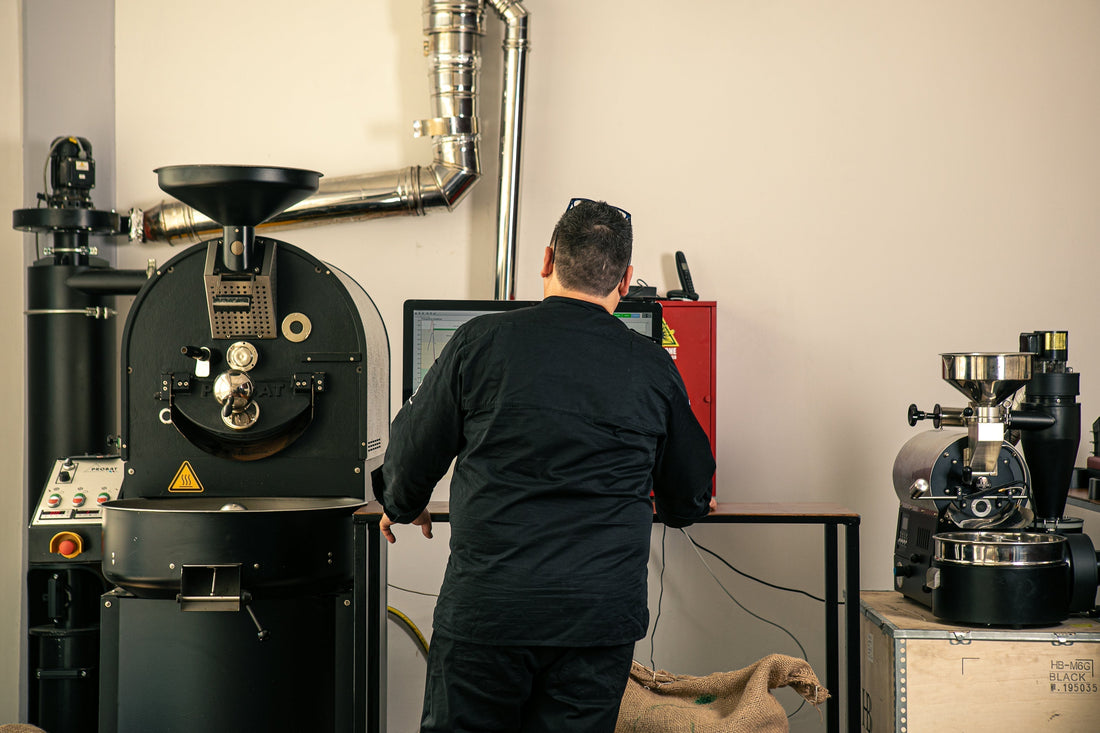
In the Heart of the Grain: The Science Hidden in a Seed
There is a moment during the roasting process when everything stops: the drum turns, the profile slides, and I find myself observing a bean that changes color, shape, structure.
It is there that I remember why I started doing this job: because each grain is a story , a complex biological system , a pure expression of its territory .
And to really tell it, we have to start from the beginning.
A seed, not just a grain
The coffee we roast every day has much more fascinating origins than it seems at first glance. It is not a simple bean, but the seed contained in the drupe of a plant belonging to the Coffea genus. It is a small berry , which can take on a red or yellow color depending on the variety, and which generally contains two paired seeds . These are the ones that, after being harvested , processed and left to dry , become what we commonly call "green coffee" . On some rarer occasions, the berry develops a single round seed, known as a peaberry .

Once dried and stabilized, the seeds present themselves in their most authentic form, even before any thermal intervention. It is in this state that the internal structure of the grain is revealed, made of ordered layers rich in substance. On the surface there is a thin silver film , adherent and protective. Immediately underneath, there is the endosperm , the bean's beating heart , where all the chemistry that will be the protagonist in the roasting is concentrated. Inside it, the embryo is still present, although now inactive.
It is precisely in the endosperm that an invisible but decisive world is hidden: a complex combination of carbohydrates, proteins, lipids, acids, alkaloids, minerals and moisture . Each of these components plays a key role in determining the sensory profile and characteristics of the cup .

Carbohydrates
Carbohydrates are the most abundant: they represent 35% to 50% of the green bean. Among these we find complex sugars such as cellulose , which has a structural function but does not participate directly in roasting; galactomannans , which contribute to viscosity and therefore to the sensation of body in the cup ; and arabinogalactans , which influence the formation of the crema , its stability and the overall texture . During roasting, these sugars are protagonists of the Maillard reaction , a process that generates hundreds of aromatic compounds , including pyrazines, furanones and thiazoles , responsible for many of the typical aromas of roasted coffee.

Proteins
Along with sugars, proteins make up between 9% and 12% of the bean. Composed of both free and bound amino acids , they also play a role in the Maillard reaction , contributing to the formation of melanoidins , responsible for the deep brown color of roasted coffee, and nitrogenous aromatic compounds that evoke notes of toast, malt, hazelnut or chocolate . A higher protein concentration can lead to greater aromatic complexity , but also to greater bitterness if the roasting is not carefully managed.

Lipids
Lipids , present in varying amounts between 10% and 15% , play a more discreet but fundamental role. Composed mainly of triglycerides , diterpenes (such as and kahweol ) and sterols , they do not undergo radical transformations during roasting, but are essential for retaining volatile aromas and for giving silkiness and persistence to the drink. A good lipid presence often translates into a denser crema , especially in espresso, and a richer cup on the palate .

Chlorogenic acids
Another important family is that of chlorogenic acids , which represent 5% to 10% of the green bean. The most relevant are 5-caffeoylquinic acid and dicaffeoylquinic acid . During roasting, these compounds degrade into quinic acid , which can give rise to bitter and astringent sensations , and caffeic acid , responsible for the bright acidity . If well managed, this degradation leads to a lively and bright cup . But if it goes too far, unpleasant, sour or medicinal notes emerge , compromising the balance of the drink. In these cases, timing and the development curve become fundamental.
Alkaloids
Among the nitrogenous compounds , two alkaloids stand out : caffeine , which is thermally stable and remains almost unchanged from the raw phase to the final cup, and trigonelline , which during roasting is transformed into nicotinamide (vitamin B3) and pyridines , aromatic molecules with a spicy and toasted profile , which recall hints of pepper, leather and earth . Trigonelline is also linked to the more floral and sweet aromas , which are expressed above all in coffees fermented naturally or with anaerobic methods .
Minerals
The minerals present in the bean – such as potassium, calcium, magnesium, phosphorus and iron – do not have an aroma of their own, but they influence various aspects of roasting and extraction . They regulate the thermal conductivity of the bean and influence the pH of the cup , modifying the perception of acidity . In particular, magnesium can accentuate the sweetness in espresso, while potassium acts on the salt balance .
Humidity
Finally, there is humidity , a fundamental component that is often overlooked. The ideal water content is between 10% and 11.5% , measured with precision. If the bean is too moist , the heat has a hard time penetrating properly. If it is too dry , however, the roasting process progresses too quickly, risking “burning” it before it can express itself at its best. Even a minimal variation – for example 0.5% – can significantly affect the behavior of the bean during roasting .
A Universe in the Seed

When we look at a green grain, we can choose whether to see it as an ingredient or as a complex organism that has traveled through time and space .
It was rain, wind, light, fermentation . It was a hand that collects, a sun that dries, air that breathes . But above all: it is pure chemistry waiting to be transformed .
Every component of a coffee – from the sugars that build its body, to the lipids that hold its aromas, to the acids and minerals that shape its character – is there for a purpose . And we, as roasters , have a duty to listen to them, understand them, and work with respect .
Green coffee is not a starting point : it is already a system perfectly designed by nature and the territory .
Roasting doesn't improve it, it reveals it .
And to do it really well, we have to start right here: from the science hidden inside a seed .
